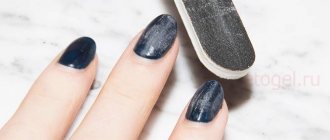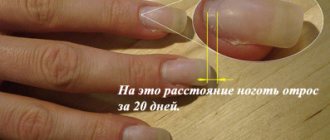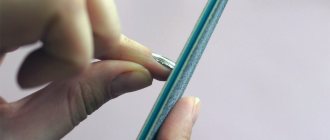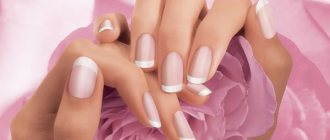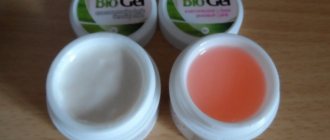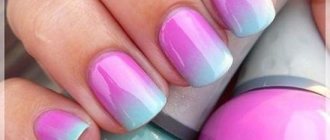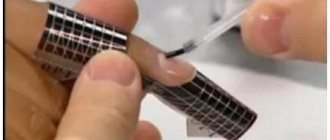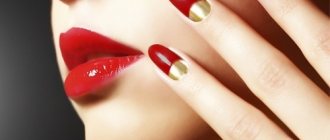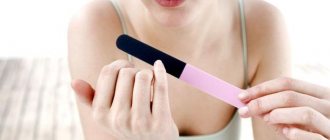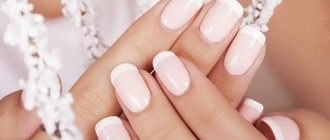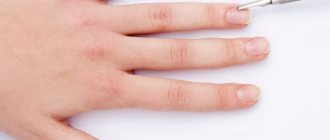A beautiful manicure is the “calling card” of a well-groomed woman. Without neat, aesthetic nails, it is unthinkable to look elegant and chic.
But, alas, natural material is not always pleasing. For one reason or another, not every woman can boast of strong, strong nails that can be grown to give a fashionable shape. And if you want something special, for example, an edgy, fashionable shape with a long length? There’s really no choice here: only build-up.
But it may happen that you need to urgently remove your nails, but there is no time or opportunity to visit a specialist. In this case, all hope is only in your own skillful hands.
Is it possible to remove extended nails yourself correctly?
Before you figure out how to remove extended nails yourself, and whether this can be done at all, a few words about what materials they are made from.
Nail extensions are, in fact, “sculpting” them from special polymer materials: acrylic or gel.
Interesting!
Both acrylic and gel are acrylates - polymer materials. The difference is in appearance and features of working with these materials. Each of them has its own advantages and disadvantages, so you need to choose based on specific conditions.
The advantages of acrylic include:
- less dust during operation;
- strength;
- low shrinkage;
- possibility of repair;
- the ability to remove it using a special solvent;
- plastic.
It also has disadvantages:
- smell;
- dullness;
- tendency to yellowing.
In turn, the gel boasts the following advantages:
- aesthetic appearance;
- hypoallergenic;
- no odor;
- resistance to chemicals.
The disadvantages include the following:
- fragility;
- impossibility of repair;
- dust from working with materials;
- reaction to temperature changes (frost or bath).
So, we have found out the main differences between the two materials for nail extensions. Both of them are a plastic mass, which then polymerizes and thus hardens: acrylic - under the influence of heat, gel - under a UV lamp.
To remove nails, the master dissolves acrylic in a special liquid, but simply files off gel nails, because they do not enter into chemical reactions, which means there is no way to dissolve them.
How to quickly remove helium nails at home
If you don’t know how to remove gel-type nail extensions at home, then be prepared for difficulties. Doing this yourself is very problematic. There are certain steps for removing gel nails at home.
- It is recommended to immediately pinch off the free edge of the nail with tweezers, while protecting the eyes from splinters and sharp edges.
- When filing the nail plate, a large amount of dust is generated, so you need to take breaks periodically to remove it using a brush, and also to see how your work is progressing.
- During the filing process, special care should be taken not to damage your own nail, especially as you approach the completion of the entire process.
- If you run a cotton swab, previously soaked in acetone, over your nail, you can see the border that runs between the natural nail and the gel. You can also apply a little pressure to the nail and feel that the gel is much harder than the natural nail.
- After almost all the gel has been removed, it is necessary to change the file to another one that has a higher degree of abrasiveness, in other words, less grainy. We continue to further file away the gel, and it is recommended to slightly reduce your pressure on the nail. At the same time, you will be able to see how the gel peels off in scales at the very base of the nail plate. However, it is too early to remove it completely. A thin gel layer will not interfere, and it will only make your nails stronger.
- Using a special polymer file, you need to thoroughly polish your nails.
- Dust that arises during filing of helium nails can greatly dry out the skin around the nail. Therefore, after the work has been completed, be sure to lubricate your nails using a nourishing cream.
If your nails were extended using a combination of acrylic and gel techniques, you will need to visit a salon, as there is a high probability of damaging your own nail by removing artificial materials at home.
If you don't know how to remove one of your nail extensions, this material will be useful for you.
First, remove the coating and use a hard file to file off the top layer of the nail, namely the top gel. This is not easy to do, since the gel is quite dense. Once you have gotten rid of the fixative, apply a special liquid for removing gel nails to a cotton pad and leave it on your nails for about 40 minutes. After which the gel will resemble jelly, and you can easily get rid of it. Upon completion of the procedure, do not forget to wash your hands with soap.
If you do not have the opportunity to make an appointment with a nail service specialist, you need to master the technique of how to remove extended nails at home.
To perform this procedure, you will need a special solution for removing artificial nails, as well as a hard file.
First you need to cut off the topcoat. It is the hardest and cutting it down will take a lot of time. Once the top gel is removed, you can begin removing the base gel. Soak a cotton pad with a special solution and leave on your nails for 40 minutes. Next, use an orange stick to get rid of the gel. If you still don’t understand how to remove extended nails at home, we recommend that you watch video tutorials where masters talk in detail about the features of this procedure.
After watching the video, all your questions will disappear and you will easily master the removal of extended nails.
When the time comes to remove extended nails, girls turn to nail service professionals because they do not know how to remove gel nail extensions on their own.
However, removing extended nails is not difficult; for this you need to have a hard file and a special solution. First, the top gel is cut off, then the solution is applied to a cotton pad and applied to the nails. The solution is left for 30-40 minutes, after which the nails can be easily removed.
Extended nails always look impressive and relevant, but the only way to remove the gel is to file the extended nails.
The most important thing in this process is to follow the rules and precautions so as not to damage the native nail plate. To begin with, use a hard file to remove the top gel; it is durable and, alas, cannot be removed any other way. Once the sealer is completely filed away, you can apply the nail extension remover solution. The solution is applied to a cotton pad and applied to the nail; for a high-quality result, it is recommended to use foil.
Girls, watching a nail technician at work, trying to figure out how to remove nails with acrylic extensions, so that I can then repeat the procedure at home.
To remove nails at home, you need to purchase a special product labeled Acrylic Remover. Next, apply the solution to a piece of cotton wool (it is better to use discs), apply it to the nail and wrap it in foil. Wait 30-40 minutes, then remove the foil. You will see that the acrylic has become soft and flexible, now you can easily remove it with a file or an orange stick.
Modern girls, wanting to get beautiful nails, are wondering what is needed for gel nail extensions? Today we will offer a list of what materials are required for gel extensions.
At the same time, you can extend your nails using both tips and forms.
Rules for self-removal of artificial nails
The main thing is to clearly understand that acrylic and gel nails are removed differently. In the first case, you need a solvent, in the second - special files.
You also need to stock up on time and patience and follow simple rules:
- read the detailed instructions on how to remove extended nails;
- prepare all the necessary materials and tools;
- take your time, be careful;
- be sure to carry out restoration measures after removing the extended nails.
The recipe for using oils in nail care is as follows:
- Take enough oil and heat it slightly on the fire
- Lubricate the nail plate with oil and then gently massage it to saturate the nail with oil. It is important to note the meaning of this procedure. At first it may seem that oil treatment is necessary solely to give your nails a shine and a well-groomed appearance, but in fact, oil treatment has a much more important purpose - to prevent unpleasant peeling of the nail plate.
- Next comes polishing. In specialized salons, as a rule, suede polishers are used. If you have this device, great, but if not, then you can resort to the services of an ordinary piece of thick suede. It is found in almost every home. A little advice if suddenly you do not specifically store a piece of suede in case of removing extended nails. Many ladies have suede boots. If you still have the box, then it should contain an additional piece of suede for filling holes in the shoes. You can easily use this piece without fear of ruining your favorite nails.
Proper nail care is absolutely necessary in the period after removing extended nails, but constant preventive maintenance of the health of your nails during normal, non-critical periods, such as after removing nails, will bring a much greater effect. Your beauty directly depends on the health of your body. This has already been mentioned at the beginning of this article and it would not be amiss to remind you of this at the end of reading the material on how to remove extended nails at home.
In themselves, extended nails are a wonderful invention created to enhance the already enormous beauty of all the girls on the planet, but like all inventions created with good intentions, without following the rules, the use of extended nails can lead to very unpleasant consequences for every girl , consequences.
Quick drying for nails
12 unusual nail polishes
Related Posts
Preliminary stage - preparation
During the procedure, all necessary materials and tools must be at hand.
What you will need to remove acrylic nails:
- Special solvent for acrylic. Sometimes it is recommended to use nail polish remover with a large percentage of acetone, but I advise you to use this product only if you find yourself on a desert island, you desperately need to remove acrylic from your nails, and you have nothing on hand other than acetone. Still, acetone greatly dries and damages nails, and it is also a toxic and extremely volatile chemical compound that is not at all good for health.
- We will make some kind of “compresses” from the liquid, so we will need material support - cotton pads and foil. I recommend preparing pieces of foil in advance that are long and wide enough to wrap around your fingertips. Cut them generously.
- A rough saw to cut off the top layer of material.
What to stock up on to remove gel nails
The gel will have to be cut off first and then filed away, which means you will need nippers and files:
- For the top layer - highly abrasive (less than 180 grit).
- Further, as you approach the nail, you need gentler files.
There will be a lot of dust during the cutting process, so you will need glasses and a mask.
Step-by-step instructions for removing extended nails from photos
The coating itself is quite fragile, but do not try to chip it off with any objects.
How to remove acrylic nail extensions at home
1. Remove unnecessary nail length. Apply scissors or a tip cutter 1-2 mm longer than the desired length. With a sharp movement, cut off the tip of the nail. When working with scissors, never make sequential cutting movements. This causes severe damage to the nails.
2. Remove the final protective coating . Using a 180 grit file, carefully go over the surface of the nail. Examine the nail from different angles, making sure that all the finishing gel has been removed.
3. Soak the acrylic.
- Wet a piece of cotton pad very well with acetone.
- We apply it to the surface of the nail and wrap it with foil, making a kind of candy. So we wrap all our fingers in turn.
- The duration of the process depends on the tightness of the acrylic to your nail.
- Periodically lift the foil and try to push the acrylic away with a wooden stick.
- Waiting time is allowed up to 20 minutes.
- A longer period can completely ruin your nails and skin. It's better to re-wrap it later.
4. Remove acrylic. Use a pusher to gently remove the coating from the nail using gentle movements. If the acrylic does not come off well in some places, do not use force. After removal, wash your hands thoroughly.
5. Shape and polish the nail. Use a hard nail file to shape the edge of the nail. Using a polishing buff, carefully file down the surface of the nail.
6. We provide nail care. Don't be alarmed, your nails look scary right after removal. Lubricate your nails and cuticles with special oil and do not apply varnish until the nail plate is completely restored.
How to remove gel nails at home
The gel coating cannot be washed off or dissolved with anything. Moreover, do not try to chip it with hard objects. Even a slightly peeling edge of the gel can come off with your nail if physically chipped. It really, really hurts.
1. Remove unnecessary nail length . We cut with scissors or a tip cutter in one sharp movement, placing the blades strictly perpendicular to the surface of the nail. Then file away all the irregularities with a file.
2. Equalize the length of the nails. Use a 100 grit hard file to even out the length of your nails. File the nail together with the gel.
3. Finger protection. A new hard file can cut the cuticle until it bleeds. It is better to first cover your finger with adhesive tape.
4. File off the gel.
- When cutting, there will be a lot of fine dust and, possibly, small fragments. The occupation is long, tedious and dirty, but very responsible.
- The gel needs to be removed with a 100 grit file right down to the nail, but without damaging your nail plate. Keep the surface of the file parallel to the surface of the nail.
- Brush off dust periodically with a stiff brush.
- Constantly inspect the nail from different angles to ensure that all the gel is removed evenly.
- Work carefully around the cuticle.
5. We carry out the final filing of the remaining gel. When the gel is almost cut off, switch to a 180 grit file. Go over the entire surface of the nail to remove any remaining gel. The work takes longer, but working near the very surface of the nail with a soft file is safer. Wet the surface of the nail with a napkin, this will show whether all the pieces of gel have been removed.
6. Polish your nails. Go over the surface with a polishing buff, but don’t overdo it, your nails have already suffered enough.
7. We provide nail care. At the end of the process, both nails and cuticles look, to put it mildly, depressingly. Immediately lubricate with oil, cream, whatever you find in the house. After removal, you need to carry out a procedure to strengthen the nail plate. Unfortunately, nails will only recover when their entire length has grown.
To restore your nails after removing the coating, be sure to give them maximum attention. Baths with herbs and sea salt, keratin-based masks, protective coatings with vitamins and targeted vitamin complexes will help revive your nails in the shortest possible time.
Removing acrylic nails
So, the time has been booked, the materials and tools have been prepared, let’s begin!
We begin the process of removing acrylic nails by cutting off the top layer with a coarse file. After the top layer is removed, the nails are no longer so strong, and you can begin to soften them.
Softening acrylic nails
To remove acrylic, you need to dissolve it with a special liquid, but this is not varnish; it cannot be removed in a couple of seconds.
Therefore, we moisten a cotton pad with liquid, place it on the nail and wrap it with foil or put on clips. This is necessary to ensure that the liquid does not evaporate too quickly.
How to properly remove acrylic nails
If the nails can no longer be corrected, they need to be removed, since the manicure no longer looks neat. This can be done using the following drugs and materials:
- acrylic nail remover;
- tip cutter or nail clippers;
- pieces of foil measuring 10x10 for each finger;
- cotton pads;
- file for acrylic nails;
- buff for polishing;
- regular nail polish remover;
- cuticle oil.
If everything you need is available, it’s time to remove your nail extensions. To remove them, you must do the following:
- If your nails are covered with varnish, it should be wiped off. To do this, soak the cotton wool in nail polish remover, then apply it to each finger.
- To facilitate the process, it is necessary to cut off the free edge without affecting the natural plate. To do this, you need to use a type cutter, which will quickly and accurately do its job. In extreme cases, nail clippers will do.
- Moisten 10 pieces of cotton wool with a special liquid for removing acrylic material. They must completely cover the surface of the plate. It is better to purchase such liquid in a specialized store. A high-quality product will speed up and facilitate the process of removing the extension.
- Each finger should be wrapped in foil. This should be done carefully, do not cut off too small pieces. The nails should be in a “greenhouse” made of foil.
- Now it's worth the wait. The optimal time is 20 minutes. During this time, the acrylic will become jelly-like. Your fingers should be warm. This temperature reaction indicates that the liquid has reacted with the artificial material.
- First, remove the foil from the finger that is warmest. Use a metal spatula or any thin, sharp object to remove the loosened material. This should be done very quickly, because in the air the acrylic will begin to thicken again.
- Repeat step 6 for all 10 fingers.
- If there is any material left on the nails, it should be sanded off. A special file is suitable for this. As a last resort, use fine-grained sandpaper.
- After sanding, carefully polish with nail buff.
- Apply cuticle oil and rub it into the nail plate. You can also make a nail bath with oils or sea salt.
How to remove gel nail extensions yourself at home
You will have to tinker with the gel. This material is solvent resistant, so it needs to be cut down.
Important!
Wear safety glasses before starting work. In the process of cutting off the free tip of the nail with tweezers, pieces of hard material will fly in different directions. It would be completely inappropriate if such a fragment flew into the eye.
After the nails are shortened, take a coarse file and file. We saw for a long time, patiently. It is better to stick an adhesive plaster on the fingers with which you hold the file, otherwise you will get calluses.
When a thin layer of material remains, wipe the surface with acetone to assess how much gel is left, then take a smaller nail file and buff the nail.
Important!
A thin layer of gel coating can and should be left on. By filing everything too hard, you risk damaging your nail, it will become thin, brittle, and you may even get injured.
Errors when removing the coating:
- Wrapping all fingers on both hands with solvent at once. If you don't have an assistant, it will be difficult.
- Failure to comply with the exposure time of the liquid to dissolve the acrylic.
- Using too rough files.
- Overzealous filing of the gel can damage the natural nail.
- Neglect of protective equipment when filing nails (masks, glasses).
- Lack of care after removing extended nails.
How to care for natural nails after removing extensions
So we did it! The artificial material is removed, and here they are, our dear nails. True, they don’t look very good. The nail plate is thinned and rough. It's not surprising, because it's damaged. Nails may become brittle.
Interesting!
You must understand that the surface of the nail plate is already damaged, and it is impossible to return it to its “pre-acrylic” state. You will have to wait until the nail grows back completely, only then can it be considered restored.
What can we do while the nail is growing?
It is best to cover your nails with medicinal varnish, which will slightly strengthen the plate and prevent it from crumbling, and also improve its appearance. In the process of growing nails, you need to carefully care for the cuticle and rub special oil into it to make the nail grow stronger.
Recommendations
"Beauty requires sacrifice". And in the case of nail extensions, we make these sacrifices. What advice would you like to give:
- Don't overuse extensions. From time to time, remove the coating and allow your nails to rest and grow completely.
- In between extensions, take good care of your nails.
- If you decide to remove your nails yourself, be especially careful.
Have you ever gotten your nails done? Which material do you prefer and why?
